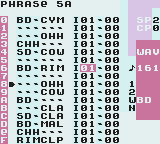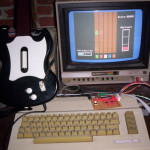Could RepRap print body parts someday?
 Watching this amazing video over at Wired is pretty much guaranteed to blow your mind. Dr. Atala is printing body parts using a setup not unlike RepRap.
Watching this amazing video over at Wired is pretty much guaranteed to blow your mind. Dr. Atala is printing body parts using a setup not unlike RepRap.
He’s using a modified HP printer with an elevator plate added to allow the device to day down multiple layers of organic cells and cross-linkers. He’s had enormous successes and has produced working bladders as well as heart constructs that actually begin beating within hours of being printed.
I’m curious whether Dr. Atala utilizes the bubblejet’s ability to spray precise patterns, or if he’s simply laying down stripes of material with each pass. If the latter is the case, I don’t see any reason why, once perfected and refined, RepRap wouldn’t be able to produce similar results, and possibly on a much larger scale.
Getting started in GameBoy music composition
Most kids wanted to be something like a fireman or an astronaut when they were growing up.


Me? I wanted to write music for videogames. Some of my favorite pieces of music came from my Commodore64 and Nintendo, classics that I still whistle whenever I find myself in an empty, echoey space.
Think about some of your early videogame experiences. How many themes can you remember? The classics are all accompanied by tunes that we remember to this day. Pacman. Zelda. Mario. Brilliant works defined as much by the restrictions of the “instrument” as by the imagination of their composer.
Well, life often takes you in different directions from your childhood dreams, but I’m lucky enough to get to play at mine as an adult. There’s a whole scene dedicated to writing music for these platforms, and I’ve been dying to dive in, but didn’t really know where to begin.
Luckily, GameBoy Genius over at 8bit collective has put together a great how-to for getting started with gameboy music, complete with a gameboy emulator and awesome tracking software for the gameboy itself. Here’s a sample of what you can create with it(mp3). The gameboy’s limitations gave it a sound very similar to the C64, which also holds a special place in my heart. There’s apparently a “getting started” guide for C64 music as well, guess what I’ll be checking out next?
 Wow, I really want to get my hands on one of these and see how they tick!
Wow, I really want to get my hands on one of these and see how they tick!
This little guy is named Zeno. He appears to be a very capable robot with 28 different motors and a flexible face for communicating emotions.
The general public got their first real look at Zeno at Wired NextFest, and he appears to have created quite a buzz.
Check out this video of Zeno in action.
Isn’t his face creepily expressive?
Most robots of this kind are unfortunately just expensive toys, limited in what they can do and essentially just playing back sequences of movement previously recorded. Zeno aims to buck that trend by hooking up wirelessly to your computer, giving it a lot more thinking power. Couple that with the AI technology by Massive, the same team behind the AI used in The Lord of the Rings and lots more films, and you’ve got an a thinking, learning robot.
It sounds insanely cool – I really hope that it’s open to tinkering and hacking once they’re available.

I started out this post looking to write a non-Arduino story, but it just wasn’t meant to be. I’m a huge fan of computer generated music, dating back to my days of playing games and composing music on the Commodore 64. I still love that classic SID sound, and was floored to hear it in the new 50 Cent and Justin Timberlake tune, Technology:
(Thanks to Kelsey Ruger for pointing out the videogame sounds in the song and Alex Hillman identifying the SID, likely coming from something like the SIDStation)

I wrote my first music on a C64 with “The Music Shop”, and after hearing this song, I want to get started in SID hacking and make my own SID powered instruments.
Well, I’m sure I’ll have more posts on that coming in the future, but while researching tonight I found myself sidetracked by Toni Westbrook‘s awesome project to bring Guitar Hero to the C64 and the SID.
A closer look reveals that Toni’s programming the ATMega8 chip that he’s got the controller wired into with, what else, an Arduino! Even digging into C64 music projects, I still ended up with an Arduino post.
Help us source conductive thread
Does anyone know where we can find conductive thread for wearables? We’ve had trouble tracking it down here in NYC. Please leave suggestions in the comments!

